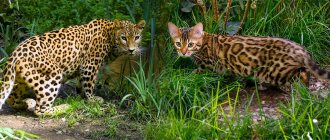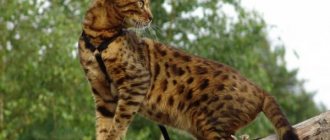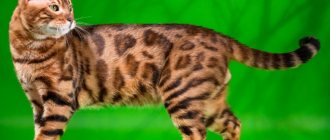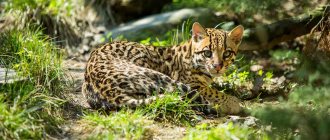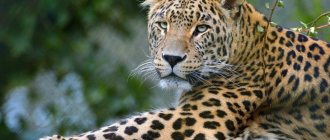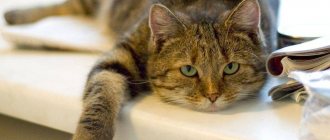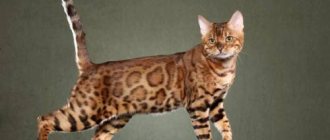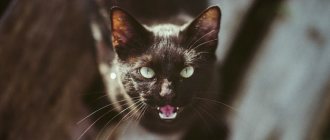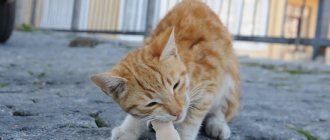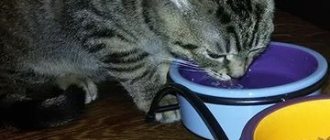Since the moment of official recognition of the Bengal cat breed, these rather exotic pets have attracted well-deserved attention. After all, Bengals are characterized not only by bright external characteristics, but also by the fun and playfulness characteristic of most cats, an open and friendly character and a well-developed intellect. Both adults and children can find a common language with a Bengal cat. Especially if the members of the family in which the Bengal appeared are accustomed to leading a healthy lifestyle and actively spending leisure time and, what is important, are sincerely ready to take care of the new pet and take responsibility for its comfortable stay with the person.
Who is best suited for a Bengal cat and how to make friends with it? What does she look like and how long does she live? What are her dispositions, habits and favorite treats? FAN presents a brief “encyclopedia” of the life of representatives of the Bengal breed.
pixabay.com/
History of the origin of the domestic Bengal cat breed
One of the names of the predecessor of the modern domestic Bengal, the Bengal wild cat, is the leopard cat. Therefore, some suggest that Bengals owe much of their origin to leopards. However, in reality, Bengal cats are no closer to it than other domestic cats, although they belong to a different genus of cats - Oriental. In general, the Bengal cat is an intergeneric hybrid between the wild Bengal and the domestic cat. From their wild ancestors, which, as we have already found out, were not leopards, these animals inherited the characteristic “spotting” and, of course, the very name of the breed - the Bengal domestic cat. Also, from their ancestors, today's cats inherited unusually beautiful shiny fur.
The Bengal cat has gone through a rather long and thorny path to the recognition of breed standards, and it was bred through the efforts and determination of the breeder-felinologist from America Jane Mill . The fact is that the founder of the breed has long been looking closely at the problem of extermination of the already mentioned leopard cats from the wild and decided that breeding domestic cats that retained the same color could attract public attention to this serious problem.
This idea was born in 1961 - during Jane's fateful trip to Bangkok, when she came into her hands with a tiny baby of a local leopard cat, which was almost impossible to tame. The wild kitten settled down with its new owner, and then the grown-up baby reproduced offspring from an ordinary domestic cat, but personal circumstances did not allow Jane to complete the formation of a new breed.
The second and decisive attempt to immortalize the endangered leopard cat in the form of its domestic clone was made by an American in 1980. The “material” for selection was leopard cat hybrids, as well as pets of various “modifications” and the golden-red Indian cat, to which future Bengals owe their shiny coat.
The process took a long time, but Jane’s efforts paid off: in 1987, the new exotic breed was successfully presented at the exhibition, and in 1991 it was officially recognized. Since then, the Bengal cat, along with other representatives of purebred domestic cats, has been admitted to exhibitions and breeding in specialized nurseries.
pixabay.com/
Wild spotted cats as pets
The custom of keeping wild animals similar to leopards at home has been known since ancient times. In recent decades, this fashion has returned again. However, not all members of the cat family are harmless enough to live with people. Among wild spotted pets, there are only three species recognized as relatively safe.
Serval
A slender cat with elongated limbs, large ears, and a miniature skull resembles a cheetah in proportions and coloring. Servals are classified as medium-sized wild cats. The average weight of the animal is 20 kg, the total length (including tail) is 1.5 meters.
In order for a Serval kitten to grow up sociable and friendly to people, the baby must be separated from its mother in the first days of life. Such conditions can only be organized by professional breeders.
Serval
A properly trained cat will be a good companion for its owners, but it must be remembered that natural instincts can manifest themselves at any time. Therefore, an adult pet should be kept in a separate enclosure.
The Serval should be fed mostly raw meat. Until your pet matures, you need to include enough foods high in calcium in your diet, since young animals with weak limbs are at high risk of fractures.
Ocelot
Ocelot
The ocelot is a predatory animal that looks like a smaller copy of a leopard. Compared to the Serval, the character of the Ocelot is more obstinate, so the animal requires keeping exclusively in an enclosure. There are cases when these beautiful animals lived with artistically gifted individuals, for example, with the artist Dali.
Geoffroy's cat
Geoffroy
This wild representative of the cat family is the same size as a domestic cat. The animal’s soft, short fur with dark spots on a golden-yellow background has long attracted manufacturers of fur products, which almost caused the extinction of the species. These animals are rarely found as pets, since domestication of kittens must begin from the first days of life.
What does a Bengal cat look like: description and breed standards
Just one quick glance at a Bengal is enough to understand that this is a representative of an exotic breed. After all, it is impossible not to notice the external differences between a Bengal cat and a “traditional” cat even at a very tender age - primarily due to its unusual “leopard” color. Needless to say, the grown-up Bengal also receives the most rave reviews. But exotic skin alone is not enough for this handsome man to be recognized as a true representative of the breed. After all, there are certain WCF standards, according to which the Bengal must be endowed with a number of characteristics.
A cat of this breed has a fairly large and muscular body: any photo of a Bengal will demonstrate this perfectly. Its paws are large and powerful, round and springy. At the same time, the hind ones are longer and more developed than the front ones. All this allows the animal to tirelessly rush around the apartment, using a dense, medium-sized tail, also endowed with “leopard” rings or spots, as a steering wheel.
The Bengal's head is placed on a strong and muscular neck, ideally proportional to the body. It is a wedge, topped with a massive chin, and the cat's muzzles are slightly thickened, due to which the muzzle of the bearer of this breed resembles a tiger's mouth. This is especially evident during growling or yawning. The cat's ears are moderately short and set high - round at the tips and wide at the base. The Bengal's nose is large, evenly wide and slightly curved. And, of course, the eyes of the true son of his wild Bengal ancestors are very, very beautiful. They are intelligent and deep, almond-shaped and clear green or golden in color.
The coat of Bengal kitties is soft and short and is practically not subject to shedding. In addition, the breed standard assumes a considerable richness of color - from the most popular spotted-striped with shades of white, red, brown or gray to, in fact, spotted - the coat is golden, and the tip of the tail is black. The merle color variation suggests the presence of “non-leopard” spots. Among this breed there are also so-called “snow leopards” - truly royal cats, painted in white and gray shades. The color palette continues with cats of rosette on gold or silver, seal-mink, charcoal and even blue.
Concluding the topic of the color of Bengal cats, it is necessary to mention such concepts as glitter and phasing. Phasing (from the English word “fuzzy” - “uncertain”) is a common phenomenon, as a result of which Bengal kittens at the age of one to four months suddenly become covered with gray or dull white hairs - so that the animal’s color appears “blurry” . Too much pronounced phasing prevents the consideration of the real color and pattern of the fur coat, but, fortunately, by eight months this effect disappears and the beauty of the fur returns in full.
Glitter is a strongly pronounced shine in a Bengal's coat, which, like phasing, does not appear in all kittens and is not a mandatory feature of the breed.
pixabay.com/
Savannah
The largest cat that looks like a leopard is the Savannah. This hybrid has the greatest resemblance to a wild animal. This is a unique and very expensive animal, the cost of an individual is from $4,000.
The breed appeared from crossing a wild serval and an ordinary domestic one; it has a large appearance with long legs, a neck, and huge ears. The official registration of the breed with all its standards in the international cat association occurred in 2011.
The signs observed in habits are as follows.
- Significantly larger than regular cats, Savannah cats are very playful and intelligent.
- They are easy to train, enjoy walking outside on a leash, do not like the cold, but are willing to swim.
- They are easily toilet trained and do not require a strict diet or special care.
- They show affection to their owners and are friends with children and other pets.
Although this is a young breed, not yet fully housetrained. The cat's habits are such that no sudden movements should be made near it, as it will immediately attack an object. In this case, no aggressive anger is observed, only a manifestation of a reflex.
What are the dimensions and weight of Bengals?
The Bengal cat has quite impressive dimensions: at the withers, an adult cat of 1.5-2 years is approximately 40-41 cm. At the same time, a cat usually weighs 3.5-5.5 kg, and a cat - 5-8 kg. However, when purchasing a Bengal pet, you need to know that in some cases there are cats of both sexes both larger and smaller than the established values. But even if your Bengal cat suddenly turns out to be “too” large, this does not mean that obesity is to blame. Most likely, such a mass arose as a result of the pet’s well-developed muscles, because due to the characteristics of the breed, Bengals are very active and energetic animals, so they are definitely not in danger of being overweight. As for the length of the cat, it is usually about 90 cm.
Kanaani
The Kanaani cat (or Canaani) is a new breed bred by an Israeli resident D. Pollacek, registered in 2000. Several breeds were crossed: Bengal, Libyan steppe, Abyssinian, common domestic and others.
The mixture of Libyan and homemade turned out to be the most successful. The animal has an independent character, distinguished by its love of walks and freedom. But the cat also adapted well to the new environment, was unpretentious in care and undemanding in nutrition. Balanced habits and love for affection do not exclude the fact that she definitely needs a leash on the street, otherwise she will run away.
The Kanaani is a breed with a short, coarse coat that ranges in color from light yellow to brown with contrasting spots. At medium size, large specimens are found.
They are strong, have well-developed muscles, high legs, on which they run quickly. It is necessary to add almond-shaped eyes and tufts on the ears of some individuals. Health is good, you just need to find a common language with your pet in order to live in harmony with it.
Features of the character and upbringing of Bengal cats
Mentally weighing the pros and cons of the breed, you should first of all understand that a Bengal kitten is like a child: everything is interesting to this nimble rascal, he strives to get into everything. Forget all your previous ideas about cats lounging all day long on a cozy lounger: the level of activity of your new friend will not allow him to sit still for long. With a high probability, the cat will follow you around the house, wanting to be involved in all the affairs of the family, and in response to being ignored, it will be seriously offended. Therefore, when purchasing a Bengal, plan to entertain him thoroughly.
How to raise this little mischief maker who can jump on you in the middle of the night, chasing imaginary prey? This process should begin as early as possible, because after eight months it will be much more difficult to rid the cat of unwanted habits. In addition, the pet will be nervous, which will certainly affect its life expectancy. Fortunately, Bengals are not only extremely smart, but also, along with other, no less exotic Abyssinian cats, they are quite easy to learn “decent manners” and train.
You will be surprised, but your pet can be taught to walk on its hind legs, roll over on command, fetch slippers, and so on. Not to mention potty training a Bengal. The pet grasps commands without much difficulty, just like the dog. Like a dog, he is ready to defend his personal territory, bring an abandoned toy to his owner, and even protect him from people, objects or household appliances that, in the animal’s opinion, are unfriendly.
Play is an important element in the development and education of a cat. She will help him express his predatory instincts safely for himself and the interior of the house. The main thing is to correctly stop possible aggressive actions of the baby. And, of course, the cat absolutely needs physical activity, without which the animal will wither away.
The Bengal cat has a bright character, in which the natural intelligence of a predator is harmoniously combined with the softness and playfulness of a domestic cat. The Bengal cat is well socialized, attached to the owner, and faithful to him, like a dog. She is sensitive to changes in the mood and atmosphere in the house, and also perfectly remembers words and intonation addressed to her. These cats love the company of people, they are quite talkative, affectionate and friendly, including other pets, including dogs, with whom the Bengal will happily make friends.
However, you should not squeeze this animal too much - the rare Bengal cat will be delighted with this.
“Five minutes of tenderness,” this is how Marina Brakstad the behavior of her pet, a Bengal named Felix.
“He will come, purr, cuddle up to me for five minutes, and then move away, he doesn’t really give into my hands, but at the same time he doesn’t go far, he’s always there,” she said.
Bengal cats also do not favor spontaneous communication with strangers: in order to make friends with house guests and begin to trust them, the animal will need time.
pixabay.com/
Basic criteria for choosing a kitten
When choosing a kitten, it is important to understand: a lot depends on the pedigree, but even champion show cats can give birth to quite ordinary kittens. When choosing a pet, the main thing is that it is healthy. Therefore, you should not buy a kitten before two months of age - it must have time to be nourished with mother’s milk and develop immunity.
When choosing a kitten, carefully examine its ears, nose and anus - they should be clean and free of discharge. A healthy kitten is agile and playful. It would be a good idea to inquire about the health of his parents.
Moving a kitten to a new home only when it reaches three months of age is a necessary condition for the success of its further development.
When choosing a kitten, it is worth keeping in mind that Bengals have three quality classes - “pet”, “breed” and “show”:
- "Show" - the most expensive, elite cats. They have an ideal pedigree, ideal appearance, parents with many titles. In addition, such Bengals have the most golden character; it is not a shame to show up at exhibitions with it. This class is very rare, not all breeders have it, therefore, if such a kitten is born, they try not to sell it and leave it in the nursery for further breeding and participation in exhibitions.
- “Breeding” - this class with ideal breed characteristics is mainly intended for producing offspring. Bengals of this class may not have a bright appearance, but their gene pool is stable, and in the future they will give birth to good kittens.
- “Pet” are Bengals for home keeping, pets, so to speak. They do not have a particularly bright, exhibition appearance; they may have a hidden defect that will only be noticed at exhibitions, but this does not make them any worse.
What is the best name for a Bengal cat?
Experiment by taking turns calling the Bengal cat that first crossed the threshold of your home with different pre-prepared names, and watch her reaction: there is a chance that she will “choose” a nickname for herself. One way or another, hissing sounds are desirable as part of the name, to which your new animal is likely to react. It is highly desirable that the cat’s name begins with the same letter as its official, “passport” name. And, of course, you should not give a new friend the name of your former pet - this is considered a bad omen, especially if the previous pet disappeared or died of illness.
For charming Bengal girls, nicknames such as Lika, Fanta, Sheba, Astra, Stesha, Dosya, Lynx or even, for example, Skoda are perfect. Stately Bengal boys can proudly bear the name Alex, Onyx, Harley, Simba, Chester, Spotty and, of course, Leo - in honor of the wild bearer of a similar spotted coat.
Features of caring for a Bengal cat
Since the Bengal kitty is short-haired, it requires less care than its shaggy counterparts. The animal is already accustomed to carefully licking its fur during fairly frequent sessions of “technical self-care.” So the owner can only brush the cat’s fur a couple of times a week using a soft rubber brush. The exception is the molting period, during which you can brush your pet more often.
Your cat's claws need to be trimmed about twice a month. The ears should be cleaned at the same frequency using a slightly moistened cotton pad. But it is recommended to brush your pet’s teeth much more often - once a week. Rare washing of the cat is also allowed. Special cat shampoos are designed for this. It is advisable to provide the Bengal with access to water, because the desire of these cats to frolic in it and fish is inherent in nature itself, so even an ordinary swim in a city bath will give the animal considerable pleasure: they can even take a shower with you.
pixabay.com/
How and what to feed a Bengal
Feeding the offspring of a leopard cat is carried out in accordance with a special feeding schedule, as well as according to the instructions of specialists. If the nutrition is complete, the baby quickly turns into a strong and healthy cat. It is important that a Bengal's diet contains a sufficient amount of protein - this is especially true for large, active and neutered cats. One way or another, approximately 90% of the menu should consist of meat and fish, as well as offal, dairy products, including cottage cheese, vitamins, minerals and polyunsaturated types of acids. The Bengal kitty will not refuse raw rabbit meat and low-fat cream, as well as vegetables - tomatoes, carrots and so on. But it is better to replace raw offal with boiled sea fish.
Bengal cats are extremely susceptible to poor quality food, which is why your pet should receive only selected food and not stagnant water to avoid loose stools and health problems.
You can also switch your Bengal cat to dry food. True, the “rule of the highest quality” should also work here: it is desirable that the popular crispy “cookies” be not just premium, but super-premium.
Health Features of the Bengal Cat Breed
The excellent health indicators of the Bengal are the result of successful breeding work combined with the natural immunity of wild beauties, taken as the basis of this breed. However, there are also certain diseases of a genetic nature, which, fortunately, can be successfully treated or avoided in most cases.
For example, one of the most characteristic phenomena is a dry nose, which is present in Bengal cats under the age of one year. Due to excessive dryness, the baby’s nose sometimes becomes covered with cracks and crusts. This is not dangerous to health, but it is better to consult a veterinarian and have the nasal surface treated so that the existing problem does not develop into an ulcerative lesion of the nose.
A more serious genetic problem is hypertrophic cardiomyopathy, which, however, with proper monitoring, regular testing and good care will allow the cat to live a long, happy life. As well as flat chest syndrome, which poses a more serious threat to survival. Fortunately, the absence of inbreeding and the use of antibiotics by a pregnant cat will reduce the occurrence of reported problems in the offspring to zero.
Bengal cats must be vaccinated on time - in accordance with the established schedule, from the age of eight weeks. Before each vaccination, a veterinary examination of the animal is required. If you want your pet to produce offspring, you will need the help of a specialist, because otherwise, even a successful mating does not guarantee the birth of full-fledged kittens. If you want to sterilize an animal, you must not miss the onset of puberty.
Answering the question of how long Bengal cats live, we can say that their average life expectancy is from 12 to 15 years, however, under the supervision of attentive and caring owners, a Bengal can easily reach its 16th birthday, while remaining in good health.
pixabay.com/
Serengeti
The Serengeti cat has the following characteristics: large ears, long legs, spotted body color and honey-colored fur around the eyes. Males are usually larger (up to 15 kg) with females weighing up to 12 kg. The behavior is more playful than with the habits of a hunter, curious, and the breed is also talkative.
The Serengeti can make a wide variety of sounds. They are characterized by dexterity and courage. For example, they attack dogs rather than hide from them. They also climb to any heights, fulfilling their curiosity, and are sociable on walks.
When breeding this breed (in America), the goal was to resemble the Serval. The Serengeti was obtained by crossing several breeds, including Bengal, Abyssinian and others. The experiment continues until now until an analogy of the serval without the admixture of its blood is derived.
How to buy a Bengal kitten and what is its cost
There are many nurseries in Russia where you can purchase a Bengal kitten. However, despite the fairly wide distribution of the breed, it is unlikely that you will be able to save money on it - unless, of course, you want to become the owner of a truly thoroughbred animal.
Before purchasing, you should find out as much information as possible about the future pet: its pedigree, character traits, general interesting facts about the breed, the subtleties of interaction between humans and Bengals. As for the price of a Bengal cat, you should know that this breed is among the top most expensive. In our country, the cost of an animal ranges from 25 thousand to 100 thousand rubles.
This is primarily due to the difficulties with breeding Bengals. The first generation of male kittens remains infertile, while their sisters are crossed with full-fledged representatives of the breed, after which a second generation is obtained, most of the males of which are also infertile. In the third generation, a minority of males already suffer from infertility, but only in the fourth generation are kittens considered full-fledged representatives of the breed. Now you know almost everything about this magnificent spotted kitty: although in order to decide whether it is worth reviving your home with it in the near future.
Ocicat
This short-haired breed was developed by crossing Siamese, American and other breeds of spotted cats. The Ocicat is a large, muscular cat with spots all over its body.
Their appearance resembles the wild mammal ocelots. These cats have a powerful and graceful body with an expanded chest. They have dense, muscular legs and a long, very flexible tail with a pointed end.
Representatives of the breed are cheerful and playful cats with a gentle character. Very affectionate and loyal, Ocicats easily get along with other pets. They require constant communication, because cats cannot be alone at all.

